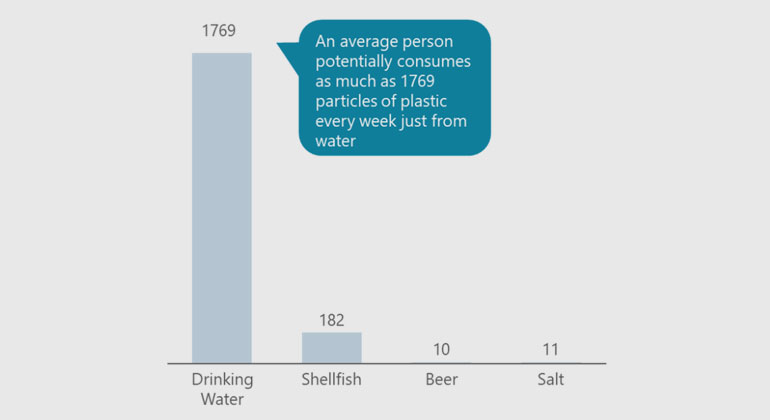Plastic ingestion by people could be equating to a credit card a week
A new study finds on average people could be ingesting approximately 5 grams of plastic every week, which is the equivalent weight of a credit card.
The analysis No Plastic in Nature: Assessing Plastic Ingestion from Nature to People prepared by Dalberg, based on a study commissioned by WWF and carried out by University of Newcastle, Australia, suggests people are consuming about 2000 tiny pieces of plastic every week. That’s approximately 21 grams a month, just over 250 grams a year.
The University of Newcastle is the first global analysis to combine data from over 50 studies on the ingestion of microplastics by people. The findings are an important step towards understanding the impact of plastic pollution on humans. It also further confirms the urgent need to address the plastic system so that it does not pollute ecosystems in the first place.
“These findings must serve as a wake-up call to governments. Not only are plastics polluting our oceans and waterways and killing marine life – it’s in all of us and we can’t escape consuming plastics. Global action is urgent and essential to tackling this crisis,” said Marco Lambertini, WWF International Director General
“While research is investigating potential negative effects of plastic on human health, we are all clear that this is a worldwide problem that can only be solved by addressing the root cause of plastic pollution. If we don’t want plastic in our bodies, we need to stop the millions of tons of plastic that continue leaking into nature every year. In order to tackle the plastic crisis, we need urgent action at government, business and consumer levels, and a global treaty with global targets to address plastic pollution,” continued Lambertini.
The study demonstrated a wide range in ingestion patterns. Whilst being mindful of the limitations of this evolving field of research, initial findings point towards a global average ingestion rate of plastic by humans of approximately 5 grams per week.
The single largest source of plastic ingestion is through water, both bottled and tap, all over the world. Large regional variations are reflected again, with twice as much plastic found in the US or India than in European or Indonesian water. Of the consumables studied, those with the highest recorded plastic levels include shellfish, beer and salt. The findings of the report demonstrate that the problem of plastic pollution is a universal one and directly affecting people. Leakage of plastic into our environment and food chain has been met so far with an inadequate global response by governments.
No Plastic in Nature: Assessing Plastic Ingestion from Nature to People calls for governments to step up and play a key role in ensuring the entire chain in the plastic system, from manufacturers to consumers, are held accountable to the common goal of ending plastic pollution. WWF is mobilising the public to support the global petition calling for a legally binding treaty on marine plastics pollution that has already garnered over 500,000 signatures. The treaty would establish national targets and transparent reporting mechanisms that extend to companies. Additionally, the treaty should provide for financial and technical support for low-income countries to scale up their waste management capacity.
“While the awareness of microplastics and their impact on the environment is increasing, this study has helped to provide an accurate calculation of ingestion rates for the first time. Developing a method for transforming counts of microplastic particles into masses will help determine the potential toxicological risks for humans moving forward,” comments Dr Thava Palanisami, project co-lead and microplastics researcher at the University of Newcastle.
Ingestion is just one aspect of a much wider plastics crisis. Plastic pollution is a major threat to wildlife, not only through microplastic ingestion but via entanglement and habitat destruction. Plastic pollution also has damaging economic consequences, with the UN Environment Programme (UNEP) estimating its annual economic impact on the ocean economy at US$8 billion.
- Please find here the 60-second campaign video.
- Download graphics here.
- Download the report by Dalberg here.
Key stats on plastic pollution:
- Overall CO2 emissions from the plastic life cycle are expected to increase by 50%, while the CO2 increase from plastic incineration is set to triple by 2030, due to wrong waste management choices.
- Eight million tonnes of plastic pollution ends up in the ocean every year.
- An additional 104 million metric tons of plastic is at risk of leakage into our ecosystems by 2030 without a drastic change in approach.
- Since 2000, the world has produced as much plastic as all the preceding years combined, a third of which is leaked into nature.
- More than 270 wildlife species have been documented as having been harmed by entanglement, while more than 240 species have been found to have ingested plastics.










